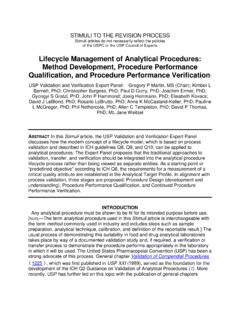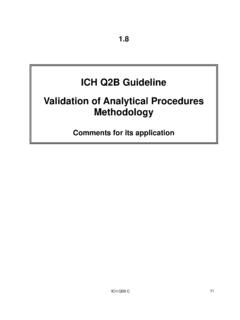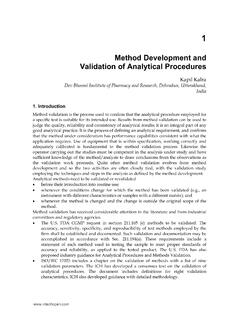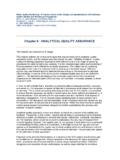Transcription of 1224 TRANSFER OF ANALYTICAL PROCEDURES TYPES OF …
1 1224 TRANSFER OF ANALYTICAL PROCEDURESINTRODUCTIONT esting to the specification of an ancillary material, intermediate, and/or ingredient and product is critical in establishing thequality of a finished dosage form. The TRANSFER of ANALYTICAL PROCEDURES (TAP), also referred to as method TRANSFER , is the docu-mented process that qualifies a laboratory (the receiving unit) to use an ANALYTICAL test procedure that originated in anotherlaboratory (the transferring unit), thus ensuring that the receiving unit has the procedural knowledge and ability to performthe transferred ANALYTICAL procedure as purpose of this general information chapter is to summarize the TYPES of transfers that may occur, including the possi-bility of waiver of any TRANSFER , and to outline the potential components of a TRANSFER protocol. The chapter does not providestatistical methods and does not encompass the TRANSFER of microbiological or biological OF TRANSFERS OF ANALYTICAL PROCEDURESTAP can be performed and demonstrated by several approaches.
2 The most common is comparative testing performed onhomogeneous lots of the target material from standard production batches or samples intentionally prepared for the test ( ,by spiking relevant accurate amounts of known impurities into samples). Other approaches include covalidation between labo-ratories, the complete or partial validation of the ANALYTICAL PROCEDURES by the receiving unit, and the TRANSFER waiver, which isan appropriately justified omission of the TRANSFER process. The tests that will be transferred, the extent of the TRANSFER activities,and the implementation strategy should be based on a risk analysis that considers the previous experience and knowledge ofthe receiving unit, the complexity and specifications of the product, and the TestingComparative testing requires the analysis of a predetermined number of samples of the same lot by both the sending andthe receiving units. Other approaches may be valid, , if the receiving unit meets a predetermined acceptance criterion forthe recovery of an impurity in a spiked product.
3 Such analysis is based on a preapproved TRANSFER protocol that stipulates thedetails of the procedure, the samples that will be used, and the predetermined acceptance criteria, including acceptable varia-bility. Meeting the predetermined acceptance criteria is necessary to assure that the receiving unit is qualified to run the Between Two or More LaboratoriesThe laboratory that performs the validation of an ANALYTICAL procedure is qualified to run the procedure. The transferring unitcan involve the receiving unit in an interlaboratory covalidation, including them as a part of the validation team at the TRANSFER -ring unit and thereby obtaining data for the assessment of reproducibility. This assessment is made using a preapproved trans-fer or validation protocol that provides the details of the procedure, the samples to be used, and the predetermined accept-ance criteria. The general chapter Validation of Compendial PROCEDURES 1225 provides useful guidance about which character-istics are appropriate for or partial revalidation is another acceptable approach for TRANSFER of a validated procedure.
4 Those characteristicsdescribed in 1225 , which are anticipated to be affected by the TRANSFER , should be WaiverThe conventional TAP may be omitted under certain circumstances. In such instances, the receiving unit is considered to bequalified to use the ANALYTICAL test PROCEDURES without comparison and generation of interlaboratory comparative data. Thefollowing examples give some scenarios that may justify the waiver of TAP: The new product s composition is comparable to that of an existing product and/or the concentration of active ingredi-ent is similar to that of an existing product and is analyzed by PROCEDURES with which the receiving unit already has expe-rience. The ANALYTICAL procedure being transferred is described in the USP NF, and is unchanged. Verifiction should apply in thiscase (see 1226 ). The ANALYTICAL procedure transferred is the same as or very similar to a procedure already in 40 General Information / 1224 TRANSFER of ANALYTICAL PROCEDURES 1 The personnel in charge of the development, validation, or routine analysis of the product at the transferring unit aremoved to the receiving eligible for TRANSFER waiver, the receiving receiving unit should document it with appropriate RECOMMENDED FOR THE TRANSFER OF ANAYTICAL PROCEDURESS everal elements, many of which may be interrelated, are recommended for a successful TAP.
5 When appropriate and as apart of pretransfer activities, the transferring unit should provide training to the receiving unit, or the receiving unit should runthe PROCEDURES and identify any issues that may need to be resolved before the TRANSFER protocol is signed. Training should transferring unit, often the development unit, is responsible for providing the ANALYTICAL procedure, the reference stand-ards, the validation reports, and any necessary documents, as well as for providing the necessary training and assistance to thereceiving unit as needed during the TRANSFER . The receiving unit may be a quality control unit, another intracompany facility, oranother company such as a contract research organization. The receiving unit provides qualified staff or properly trains thestaff before the TRANSFER , ensures that the facilities and instrumentation are properly calibrated and qualified as needed, andverifies that the laboratory systems are in compliance with applicable regulations and in-house general laboratory the transferring and receiving units should compare and discuss data as well as any deviations from the protocol.
6 Thisdiscussion addresses any necessary corrections or updates to the final report and the ANALYTICAL procedure as necessary to re-produce the single lot of the article may be used for the TRANSFER , because the aim of the TRANSFER is not related to the manufacturingprocess but rather to the evaluation of the ANALYTICAL procedure s performance at the receiving PROTOCOLA well-designed protocol should be discussed, agreed upon, and documented before the implementation of TAP. The docu-ment expresses a consensus between the parties, indicating an intended execution strategy, and should include each party srequirements and responsibilities. It is recommended that the protocol contain the following topics as appropriate: objective,scope, responsibilities of the transferring and receiving units, materials and instruments that will be used, ANALYTICAL procedure,experimental design, and acceptance criteria for all tests and/or methods included in the TRANSFER . Based on the validation dataand procedural knowledge, the TRANSFER protocol should identify the specific ANALYTICAL performance characteristics (see 1225 and 1226 ) that will be evaluated and the analysis that will be used to evaluate acceptable outcomes of the TRANSFER TRANSFER acceptance criteria, which are based on method performance and historical data from stability and release re-sults, if available, should include the comparability criteria for results from all study sites.
7 These criteria may be derived usingstatistical principles based on the difference between mean values and established ranges and should be accompanied by anestimation of the variability ( , percent relative standard deviation [%RSD] for each site), particularly for the intermediateprecision %RSD of the receiving unit and/or a statistical method for the comparison of the means for assay and content uni-formity tests. In instances of impurity testing, where precision may be poorer such as in the case of trace impurities, a simpledescriptive approach can be used. Dissolution can be evaluated by a comparison of the dissolution profiles using the similarityfactor f2 or by comparison of data at the specified time points. The laboratories should provide appropriate rationale for anyanalytical performance characteristic not included. The materials, reference standards, samples, instruments, and instrumentalparameters that will be used should be is recommended that expired, aged, or spiked samples be carefully chosen and evaluated to identify potential problemsrelated to differences in sample preparation equipment and to evaluate the impact of potential aberrant results on marketedproducts.
8 The documentation section of the TRANSFER protocol may include report forms to ensure consistent recording of re-sults and to improve consistency between laboratories. This section should contain the additional information that will be in-cluded with the results, such as example chromatograms and spectra, along with additional information in case of a protocol should also explain how any deviation from the acceptance criteria will be managed. Any changes to the transferprotocol following failure of an acceptance criterion must be approved before collection of additional ANALYTICAL PROCEDUREThe procedure should be written with sufficient detail and explicit instructions, so that a trained analyst can perform it with-out difficulty. A pretransfer meeting between the transferring and receiving units is helpful to clarify any issues and answer anyquestions regarding the TRANSFER process. If complete or partial validation data exist, they should be available to the receivingunit, along with any technical details required to perform the test in question.
9 In some cases it may be useful for the individu-als who were involved with the initial development or validation to be on site during the TRANSFER . The number of replicatesand injection sequences in the case of liquid or gas chromatography should be clearly expressed, and, in the case of dissolu-tion testing, the number of individual dosage units should be 1224 TRANSFER of ANALYTICAL PROCEDURES / General InformationUSP 40 TRANSFER REPORTWhen the TAP is successfully completed, the receiving unit should prepare a TRANSFER report that describes the results ob-tained in relation to the acceptance criteria, along with conclusions that confirm that the receiving unit is now qualified to runthe procedure. Any deviations should be thoroughly documented and justified. If the acceptance criteria are met, the TAP issuccessful and the receiving unit is qualified to run the procedure. Otherwise, the procedure cannot be considered transferreduntil effective remedial steps are adopted in order to meet the acceptance criteria.
10 An investigation may provide guidanceabout the nature and extent of the remedial steps, which may vary from further training and clarification to more complexapproaches, depending on the particular 40 General Information / 1224 TRANSFER of ANALYTICAL PROCEDURES 3






